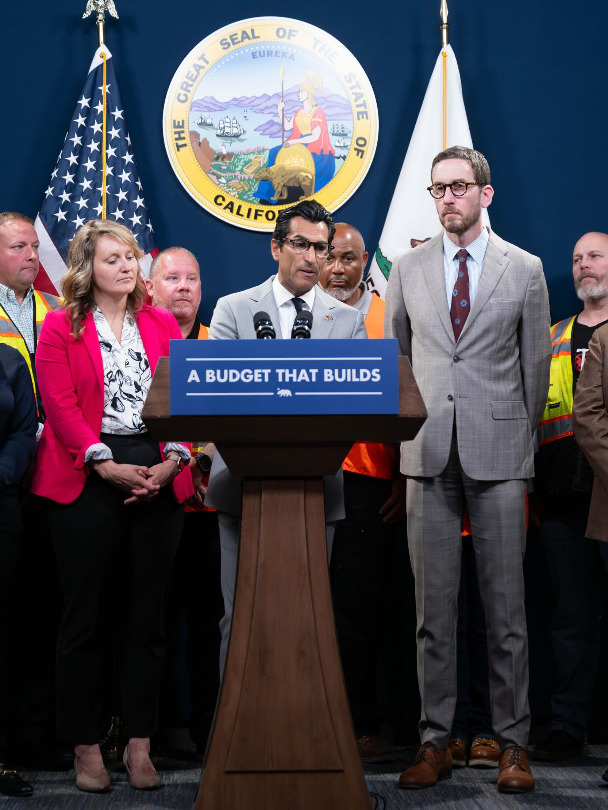The Homework: July 3, 2025

Welcome to the July 3, 2025 Main edition of The Homework, the official newsletter of California YIMBY — legislative updates, news clips, housing research and analysis, and the latest writings from the California YIMBY team.
News from Sacramento
A Week of Victory Alerts: CEQA Reform Passes, Transit-Oriented Development Advances
During the past week, California Governor Gavin Newsom signed some of the most historic pro-housing legislation of the modern era. California YIMBY-sponsored and supported reforms of the California Environmental Quality Act (CEQA) are now state law – meaning it will be faster, easier, and less costly to build new homes across the state.
As part of our 2025 Legislative Package, California YIMBY co-sponsored AB 609 (Wicks), a landmark CEQA reform that creates a clean exemption for environmentally-friendly infill housing in existing urban areas. The bill passed through the Assembly with strong bipartisan support, and was headed to the Senate, where we anticipated a tougher fight.
But in a major turning point, Governor Newsom announced during his May Revise press conference that he wanted the core provisions of AB 609 and California YIMBY-supported SB 607 (Wiener) included in the state budget.
A public endorsement like this from the Governor is rare – and a big deal.
By the end of June, “trailer bill” language – legislation that includes the state budget – was released for AB 130, the housing budget trailer bill, which included nearly all of AB 609, along with new labor standards that will require prevailing wage for new housing over 85 feet in height, and for 100% affordable housing, that takes advantage of the CEQA exemptions. At the same time, language from SB 131 was released, incorporating many of the elements of SB 607.
On June 30th, AB 130 and SB 131 were heard in the Budget Committees, passed both floors the same day, and were signed into law by the Governor just hours later to beat the midnight deadline for budget approval.
With the Governor’s signature, AB 130 and SB 131 immediately went into effect and are now the law of the land. Any infill housing project now proposed in the state of California that is under 85 feet is now exempt from CEQA, and will not be subject to any labor provisions. In addition, re-zonings that are required as a part of state-approved housing elements will also be exempt from CEQA.
This is a historic victory for infill housing and CEQA reform. California YIMBY and the entire YIMBY movement have been working towards this goal for over eight years; thanks to the strong leadership of Governor Newsom, our housing champions in the legislature, and our passionate grassroots YIMBY supporters, we’ve now achieved this goal.
The Hits Keep Coming
In addition to CEQA reform, the following bills passed their first policy committee of the second house:
- SB 79 (Wiener): Will make it faster and easier to build multi-family housing near transit stops, like train and rapid bus lines, by making it legal for more homes to be built in these areas, and streamlining existing permit review processes.
- Passed out of the Assembly Housing Committee, and now heads to Assembly Local Government.
- AB 1061 (Quirk-Silva): Makes it easier to increase the number of homes—including duplexes—in single-family neighborhoods by allowing the California HOME Act (SB 9, 2021) to be used in historic districts.
- Passed the Senate Housing Committee, now heads to the Senate Local Government Committee.
- AB 253 (Ward): Speeds up the approval process for new homes by allowing home builders to hire a licensed and certified third-party reviewer for review of housing permit applications if the local government cannot or does not complete their permit review within 30 days.
- Passed out of Senate Local Government, now heads to the Senate Housing Committee.
- AB 1154 (Juan Carrillo): Removes owner-occupancy requirements for “junior” ADUs (ADUs built within an existing home) that do not share sanitation facilities with the existing structure. It will also exempt small ADUs under 500 square feet from parking requirements, similar to existing exemption for JADUs.
- Passed out of the Senate Housing Committee, and now heads to Senate Local Government Committee.
- SB 9 (Arreguín): Ensures that local laws governing the construction of accessory dwelling units (ADUs) align with state law, and provides a pathway to eliminate unlawful local barriers to ADUs.
- Passed the Assembly Housing Committee, now heads to the Assembly Local Government Committee.
- AB 413 (Fong): Requires the California Department of Housing & Community Development (HCD) to translate key state housing guidelines and handbooks into the non-English languages commonly spoken in California.
- Passed the Senate Housing Committee, now heads to the Senate Appropriation Committee.
Our only bill yet to have a hearing is AB 1308 (Hoover), which would speed up the post-entitlement process by requiring building departments to provide estimated timeframes for permit inspections and allowing applicants to contract with private professionals for inspections. This bill was scheduled to be heard in the Senate Local Government Committee on July 2nd, but got pushed back to July 9th by the Chair of the Committee.
To stay current on what housing bills California YIMBY is sponsoring and supporting, you can now use our Abstract link to track with us.
Be sure to stay tuned for future editions of The Homework (and follow California YIMBY’s Twitter and Bluesky channels), to stay current on housing policy research, news, and legislative updates.
Housing Research & Analysis
Have the Suburbs Reached Their Housing Limit?
American home building has slowed down significantly over the past 25 years. If the U.S. housing stock had grown from 2000 to 2020 at the same rate as it did from 1980 to 2000, there would be 15 million more homes today.
The slowdown even occurred in Sun Belt cities like Phoenix, Miami, and Dallas, which were once considered “building superstars.” This decline is particularly happening in suburban areas with vast, empty land, where building should be the easiest. Yet these metros may have systematically restricted their growth through regulatory barriers that override market signals.
In “America’s Housing Supply Problem: The Closing of the Suburban Frontier?” Edward L. Glaeser and Joseph Gyourko analyzed housing construction across 44 major metropolitan areas from 1970 to 2020 to understand why markets that built over 50 million homes from 1950 to 1980 now struggle to add housing despite available land.
Key Takeaways:
- Building superstars stopped building. Growth rates dropped across Sun Belt metros, and by the 2010s, each had similarly low rates of housing supply growth.
- High prices no longer trigger more building: Expensive neighborhoods used to see the most construction, but this relationship weakened dramatically across most cities between 1970 and 2020.
- Dense areas are now building more relative to suburbs: Construction patterns have reversed, with dense neighborhoods now seeing more building than suburban areas with ample capacity. For example, Miami built 44% of new housing in desirable low-density regions in the 1970s, but only 12% by the 2010s.
Marchetti’s Constant: Still Constant – Even in Texas
Texas has long been America’s poster child for more affordable housing, thanks to its minimal regulations and abundant land. However, this hasn’t prevented Texas cities like Austin from developing the same cost pressures as California’s metro areas, which built far less over the past 50 years.
While regulations and topography account for a significant portion of the rising costs, a recent study also finds that all growing metropolitan regions experience similar cost escalations, regardless of the state’s regulatory reputation. They exhaust cheap suburban land, reach commuting distance limits, and face expensive urban construction requirements.
In “Houston, You Have a Problem: How Large Cities Accommodate More Housing,” Anthony W. Orlando and Christian L. Redfearn tracked where developers built housing across eight major metropolitan areas from 1970 to 2010. Their analysis explains why even pro-development Texas now faces similar affordability challenges to those in California.
Key Takeaways:
- Cheap suburban land has been exhausted: Austin’s share of neighborhoods with fewer than 50 homes per square mile dropped from 55.7% in 1970 to 10.6% today, while Houston’s share fell from 32.6% to 5.5%, forcing builders to turn to more expensive apartment construction that requires elevators and reinforced foundations.
- The distance from downtown shifts from a positive to a negative predictor for construction: Distance from city centers shifted from a factor that encouraged new housing development in the 1980s to discouraging it by 2010-2015 across all eight metros, as suburban expansion hit practical commuting limits.
- Property owners in desirable areas resist development, regardless of state politics. Both Texas and California metros exhibit remarkably similar neighborhood transition rates (e.g., dense suburbs progressing into more urban areas) despite having different reputations for regulation. Existing owners can afford to resist change, which raises land assembly costs, potentially resulting in premiums of up to 40% in dense areas.
Houser Headlines
- In California, Pro-Housing ‘Abundance’ Fans Rewrite an Environmental Landmark
- California Rolls Back Its Landmark Environmental Law – The New York Times
- One of the biggest obstacles to building new CA housing has now vanished
- Can weaker environmental rules help fight climate change? California just bet yes.
- Newsom signs laws that pave way for more housing in California
- California is about to roll back a landmark environmental law – POLITICO
- Scott Wiener on ‘the most consequential housing reform we’ve seen in modern history’
- California finally passed CEQA reform. Will it stop housing roadblocks?
- New California Environmental Rollbacks Could Boost Housing Projects in Fresno
- California just overhauled its main environmental law. Here’s what it means for San Diego
- California Is Running Out of Safe Places to Build Homes Due to Fires, Rising Seas
- This boomer ex-mayor lives in an $1,800-a-month 400-square-foot backyard cottage in her California suburb
- The latest strategy by SF neighborhoods to avoid development? Be ‘historic’
- Sacramento overhauls development process to speed up housing projects
- San Jose approves more than $10 million in tax and fee waivers to spur housing construction
- This rich California city is losing its mind over a housing project — and it shows why new rules are needed
YIMBY Social – Top Posts

Share the good word
We welcome your ideas and feedback — send story tips and ideas to Homework@cayimby.org.